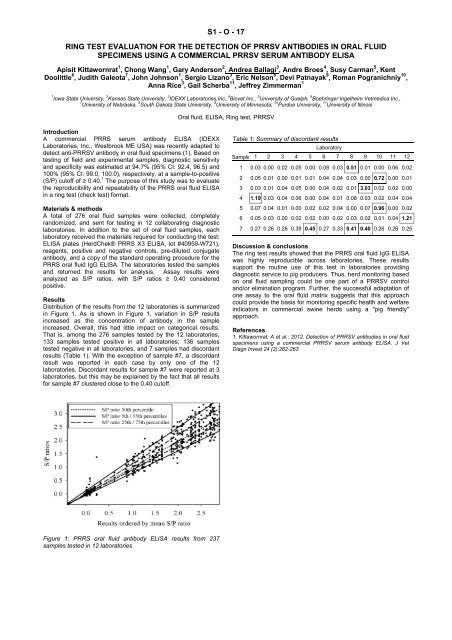Abstract Book of EAVLD2012 - eavld congress 2012
Abstract Book of EAVLD2012 - eavld congress 2012
Abstract Book of EAVLD2012 - eavld congress 2012
Create successful ePaper yourself
Turn your PDF publications into a flip-book with our unique Google optimized e-Paper software.
S1 - O - 17<br />
RING TEST EVALUATION FOR THE DETECTION OF PRRSV ANTIBODIES IN ORAL FLUID<br />
SPECIMENS USING A COMMERCIAL PRRSV SERUM ANTIBODY ELISA<br />
Apisit Kittawornrat 1 , Chong Wang 1 , Gary Anderson 2 , Andrea Ballagi 3 , Andre Broes 4 , Susy Carman 5 , Kent<br />
Doolittle 6 , Judith Galeota 7 , John Johnson 1 , Sergio Lizano 3 , Eric Nelson 8 , Devi Patnayak 9 , Roman Pogranichniy 10 ,<br />
Anna Rice 3 , Gail Scherba 11 , Jeffrey Zimmerman 1<br />
1 Iowa State University, 2 Kansas State University, 3 IDEXX Laboratories,Inc., 4 Biovet Inc., 5 University <strong>of</strong> Guelph, 6 Boehringer Ingelheim Vetmedica Inc.,<br />
7 University <strong>of</strong> Nebraska, 8 South Dakota State University, 9 University <strong>of</strong> Minnesota, 10 Purdue University, 11 University <strong>of</strong> Illinois<br />
Oral fluid, ELISA, Ring test, PRRSV<br />
Introduction<br />
A commercial PRRS serum antibody ELISA (IDEXX<br />
Laboratories, Inc., Westbrook ME USA) was recently adapted to<br />
detect anti-PRRSV antibody in oral fluid specimens (1). Based on<br />
testing <strong>of</strong> field and experimental samples, diagnostic sensitivity<br />
and specificity was estimated at 94.7% (95% CI: 92.4, 96.5) and<br />
100% (95% CI: 99.0, 100.0), respectively, at a sample-to-positive<br />
(S/P) cut<strong>of</strong>f <strong>of</strong> ≥ 0.40. 1 The purpose <strong>of</strong> this study was to evaluate<br />
the reproducibility and repeatability <strong>of</strong> the PRRS oral fluid ELISA<br />
in a ring test (check test) format.<br />
Materials & methods<br />
A total <strong>of</strong> 276 oral fluid samples were collected, completely<br />
randomized, and sent for testing in 12 collaborating diagnostic<br />
laboratories. In addition to the set <strong>of</strong> oral fluid samples, each<br />
laboratory received the materials required for conducting the test:<br />
ELISA plates (HerdChek® PRRS X3 ELISA, lot #40959-W721),<br />
reagents, positive and negative controls, pre-diluted conjugate<br />
antibody, and a copy <strong>of</strong> the standard operating procedure for the<br />
PRRS oral fluid IgG ELISA. The laboratories tested the samples<br />
and returned the results for analysis. Assay results were<br />
analyzed as S/P ratios, with S/P ratios ≥ 0.40 considered<br />
positive.<br />
Results<br />
Distribution <strong>of</strong> the results from the 12 laboratories is summarized<br />
in Figure 1. As is shown in Figure 1, variation in S/P results<br />
increased as the concentration <strong>of</strong> antibody in the sample<br />
increased. Overall, this had little impact on categorical results.<br />
That is, among the 276 samples tested by the 12 laboratories,<br />
133 samples tested positive in all laboratories; 136 samples<br />
tested negative in all laboratories, and 7 samples had discordant<br />
results (Table 1). With the exception <strong>of</strong> sample #7, a discordant<br />
result was reported in each case by only one <strong>of</strong> the 12<br />
laboratories. Discordant results for sample #7 were reported at 3<br />
laboratories, but this may be explained by the fact that all results<br />
for sample #7 clustered close to the 0.40 cut<strong>of</strong>f.<br />
Table 1: Summary <strong>of</strong> discordant results<br />
Laboratory<br />
Sample 1 2 3 4 5 6 7 8 9 10 11 12<br />
1 0.03 0.00 0.02 0.05 0.00 0.08 0.03 0.51 0.01 0.00 0.06 0.02<br />
2 0.05 0.01 0.00 0.01 0.01 0.04 0.04 0.03 0.00 0.72 0.00 0.01<br />
3 0.03 0.01 0.04 0.05 0.00 0.04 0.02 0.01 3.03 0.02 0.02 0.00<br />
4 1.19 0.03 0.04 0.06 0.00 0.04 0.01 0.08 0.03 0.02 0.04 0.04<br />
5 0.07 0.04 0.01 0.00 0.02 0.02 0.04 0.00 0.07 0.96 0.00 0.02<br />
6 0.05 0.03 0.00 0.02 0.02 0.00 0.02 0.03 0.02 0.01 0.04 1.21<br />
7 0.27 0.26 0.26 0.39 0.45 0.27 0.33 0.41 0.40 0.26 0.26 0.25<br />
Discussion & conclusions<br />
The ring test results showed that the PRRS oral fluid IgG ELISA<br />
was highly reproducible across laboratories. These results<br />
support the routine use <strong>of</strong> this test in laboratories providing<br />
diagnostic service to pig producers. Thus, herd monitoring based<br />
on oral fluid sampling could be one part <strong>of</strong> a PRRSV control<br />
and/or elimination program. Further, the successful adaptation <strong>of</strong><br />
one assay to the oral fluid matrix suggests that this approach<br />
could provide the basis for monitoring specific health and welfare<br />
indicators in commercial swine herds using a "pig friendly"<br />
approach.<br />
References<br />
1. Kittawornrat, A et al.: <strong>2012</strong>. Detection <strong>of</strong> PRRSV antibodies in oral fluid<br />
specimens using a commercial PRRSV serum antibody ELISA. J Vet<br />
Diagn Invest 24 (2):262-263<br />
Figure 1: PRRS oral fluid antibody ELISA results from 237<br />
samples tested in 12 laboratories


